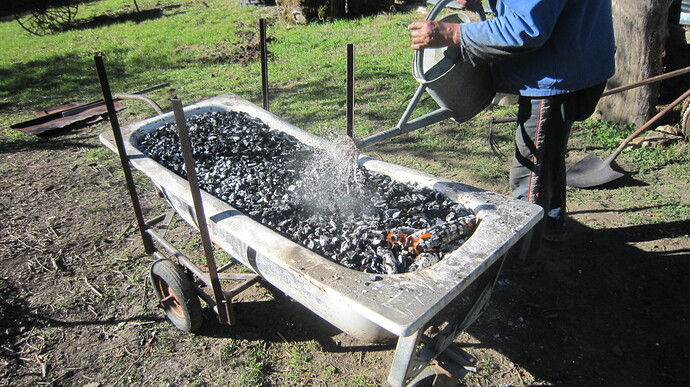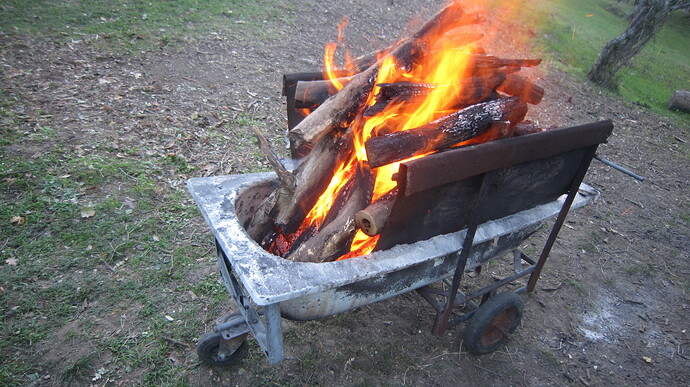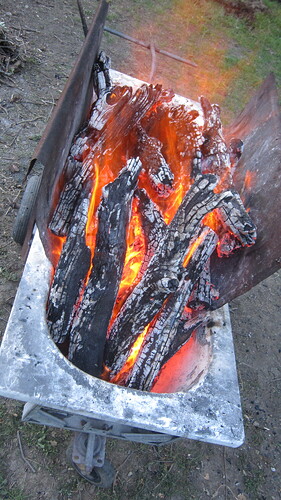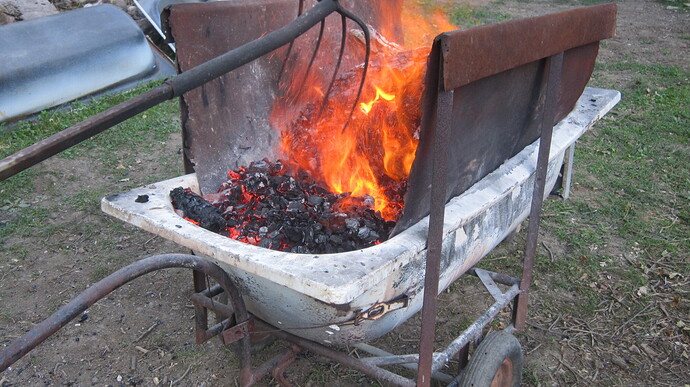Provisorium. A word I was not familiar with before. Old dog, new tricks. ![]()
Keep in mind nothing lasts forever. I tend to think to myself “This will do for now. I can always improve on it later.” But that rarely happens. Most of my projects end up permanent provisoriums. Maybe I’d go a different route if I knew I would be up and about for 200 years ![]()
J-O, that statement tells me you are making better provisoriums than me. I get sick and tired of them long before that. ![]()
I doubt it, Johan. Maybe I’m just more used to being sick and tired ![]()
I am soooo jealous of that shiny tank!
such stuff is not easy to find, the right connections are needed…my son asked since a while jesus for a storage tank for the charcoal, and this wine container appeared on internet market, only less 10 kilometers distance and only thousand euros, cheap i will say because normally this stuff costs a lot more and in our surrounding is normally nothing to find…and the owner has also found a possibility for the transport near to us where we can pick it up with the tractor…
the owner some time ago took it from far away for water storage, but with the weight of 5ooo liters water the legs entered in the ground and it was like the tower of pisa, therefore he sold it because he likes not to build a solid basement…he has only thrown some rocks on the ground and concrete on it, but of course this cannot keep…he changed to plastik containers now…
Wow, given the choice between stainless steel and plastic, I would have found a way to make the metal tank work. Great score on your part!
We had nice weather for charcoaling yesterday. I was finally able to try the bathtub method. It was a learning experience ![]() . The bathtub was faster than the barrel method, because I could load it with longer and bigger branches, and let branches too long for the tub burn off rather than going and getting a saw. When I got the tub, I had a few to choose from. I went with the cast iron instead of steel, figuring that would be stronger and handle the heat better. It worked fine for the first half-hour or so. When the fire got going pretty well, and I could really feel the heat, I heard a loud PANGGGG. Later inspection showed “D”-shaped hole about two feet/60 cm long, cracked in one side. It still works okay, but I don’t think it will tolerate much thermal cycling. Next time I’ll try steel, which should be a lot easier to move around.
. The bathtub was faster than the barrel method, because I could load it with longer and bigger branches, and let branches too long for the tub burn off rather than going and getting a saw. When I got the tub, I had a few to choose from. I went with the cast iron instead of steel, figuring that would be stronger and handle the heat better. It worked fine for the first half-hour or so. When the fire got going pretty well, and I could really feel the heat, I heard a loud PANGGGG. Later inspection showed “D”-shaped hole about two feet/60 cm long, cracked in one side. It still works okay, but I don’t think it will tolerate much thermal cycling. Next time I’ll try steel, which should be a lot easier to move around.
I used some metal roofing to try to seal the tub when I finished. It didn’t seem like I could seal it well enough to keep the char from burning up, so I shoveled the char into the barrel I’ve used before, and covered it up. I was surprised that a little less than half a bathtub full of char produced a little less than half a barrel. I was thinking the tub would be a lot larger. It pays to measure, not just estimate. I’ll probably use the tub until the cracked part falls out, then go back to the barrel until I can find a steel tub. I’m satisfied with either method, and still amazed that such simple methods produce such a useful material. Thankful, too. What a wonderful world ![]()
kent, thank you for sharing your experience…i have also some cast iron bath tubs, but thought to save them for later when the steel ones are rusted away…also the steel ones are lighter.
only thing i have made with the cast one is when the steel one on the cart is full with hot glowing coal, i shoveled the coal in the cast one for sealing with ash and cooling down…this is also a quick temperature change for the cast bath tub,from cold immediately to hot glowing coal, but till now no damage.(i have no barrels , so i cool it down in a separate bath tub, and the moveable tub with the wheels i use for firing.
one bath tub really full with coal makes about 200 liters, sieved than 150 liters…
when shoveling from the burning tub in the other tub, there is the occassion to add some water for helping cooling down…i tried last year, but the water was not enough , so next time coaling i will try again with a bit more water, but of corse will not get wet coal, the water and steam should only help to cool down quicker…
ps. my son remembered me we have also burnt twigs in a cast iron tub 2 years ago without demage…maybee your crack doesnt matter, only now the tension from the metal has gone away…
recently we coaled a lot of twigs, now the coal container - 5000 liters- is full…prof tone says this would be aequivalent of 1000 liters diesel fuel…
this was a good occassion for testing how much water is needed to cool down the 200 liter bathtub in way that it is not too much water ( ash glues on too damp coal) and not too less water (coal heats up again)…
8 liter water, distribuited with a watering can over the surface, makes a perfect result…the coal cools down over night nearly completely, next morning when shuffeling the coal in a barrel with 200 liters, i found only litterally one spark of glowing coal (two times, one times a bit more glowing pieces…in the early morning good to see)
i tried also with 10 liters and 12 liters, but the coal remains too damp and the ash not goes so good away during sieving,
less water, for example 4 liters and 6 liters are not able too cool down the coal definitely, only for a while, but than heats up again as if it would not have got water.
the procedure is, if the bath tub is full, i give a bit of water on the half or 2 third parts of the surface, to avoid the upper coal goes in ash while there is no flame cap more , on the rest of the surface can burn some not complete charred pieces what i search with the rake) further, when they are redy, i give also there a bit of water…than i make a grove in the leght direction with the shuffel in way that the water can enter deeper in the center…than giving the nearly whole quantity of water over the coal, looking that the grove gots enough water…than closing the grove with the shuffel, making a even surface with the shuffel and giving the rest of the water -1 liter- over parts where is hot coal.
than i cover all with a layer of used ash from the last sieving and pressing it with the shuffel.
can happen that somewhere a steam geysir brakes through, this hole is to close after, when the steam pression stops…
the ash becomes a bit moist, but dries out durng day and night with the rest of heat in the coal, so no problem with sieving…than i cover the bath tub with a metal roof sheet because of eventual wind, storm or rain…
mor up i reported from a bath tub, that was cooled down over night completely without water…i suspected it was the use of ash from sieving, but was not able to repeat this effect…
in reality it was the material what i used for coaling, it was a big pile of dry ivy twigs…probably this was the reason, but maybee it tells also something about coal quality of ivy, or because the ivy was old, two years…
sweet chestnut is not a real hard wood, so thick pieces also can be charred relatively quick…soon they brake in pieces when stirring a bit with the fork
I love your portable chacoal maker. Good use of a old bathtub.





